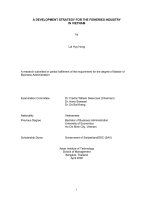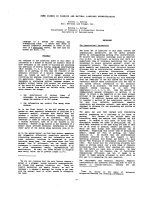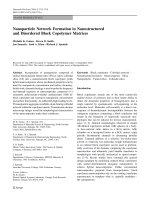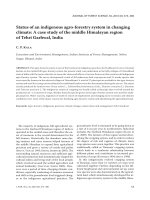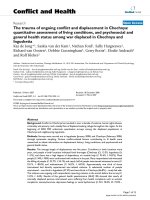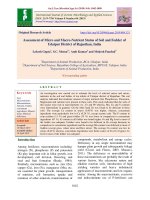Soil fertility status of some villages in Khordha and Bhubaneswar block of Khordha district under north eastern Ghat agro climatic zone of Odisha, India
Bạn đang xem bản rút gọn của tài liệu. Xem và tải ngay bản đầy đủ của tài liệu tại đây (288.23 KB, 9 trang )
Int.J.Curr.Microbiol.App.Sci (2019) 8(1): xx-xx
International Journal of Current Microbiology and Applied Sciences
ISSN: 2319-7706 Volume 8 Number 01 (2019)
Journal homepage:
Original Research Article
/>
Soil Fertility Status of Some Villages in Khordha and Bhubaneswar
Block of Khordha District under North Eastern Ghat Agro
Climatic Zone of Odisha, India
Nibedita Swain1, Antaryami Mishra2, Subhashis Saren2, Prava Kiran Dash2*,
Manoranjan Digal3 and Bbhuti Bhusan Mishra1
1
Department of Botany, College of Basic Science and Humanities, OUAT
Department of Soil Science and Agricultural Chemistry, College of Agriculture, OUAT
3
Department of Chemistry, College of Basic Science and Humanities, Odisha University of
Agriculture and Technology, Bhubaneswar, Odisha–751003, India
2
*Corresponding author
ABSTRACT
Keywords
Soil fertility, Agro
Climatic Zone,
Khordha, Odisha
Article Info
Accepted:
04 December 2018
Available Online:
10 January 2019
A soil fertility status inventory work was carried out in some villages of Khordha and
Bhubaneswar blocks belonging to Khordha district located in the North-Eastern Ghats
Agro Climatic Zone of Odisha, India. Results show that soil texture of the villages under
investigation varied from loamy sand to clay loam. Clay content varied from 2.4 to 34.0
percent. Soil pH ranged between 4.24 and 6.93 and electrical conductivity of the entire
study area remained below 1 dSm-1. Soil Organic Carbon (SOC) content ranged between
1.1 to 11.6 g kg-1. Available nitrogen content in these soils was found to be varying
between 50.0 to 225.0 kg ha-1. Available Bray‟s phosphorus content varied from 11.3 to
2326.5 kg ha-1. Available soil potassium content varied widely from 37.6 to 458.3 kg ha -1.
CaCl2extractable soil sulphur varied from 2.17 to 11.02 mg kg -1. Hot water soluble boron
content ranged from 0.91 to 2.68 mg kg-1. All the figures in lower range were found in
upland soils while the higher values for all the parameters were found in low land soils.
Introduction
Khordha and Bhubaneswar blocks belong to
Khordha district which comes under North
Eastern Ghat Agro Climatic Zone of Odisha
(Nanda et al., 2008). As per modern system of
soil classification “Soil Taxonomy” the soils
of Khordha district are classified under the
Alfisols, Inceptisols and Entisols (Sahu and
Mishra, 2005). Proper application of fertilizers
helps in maximizing marketable yields
whereas excessive use may be harmful to the
environment. Hence, evaluation of soil
fertility status of different land types of an
area is of primary importance for a balanced
application of fertilizers and manures as well
as to increase the productivity per unit of
cultivable land to cater the growing need of
cereals, pulses, oil seeds, fruits and vegetables
for the growing population. In the present
415
Int.J.Curr.Microbiol.App.Sci (2019) 8(1): xx-xx
scenario, soil testing is now considered as an
important tool for the recommendation of
fertilizer doses for various crops. Again, GPS
(Global Positioning System) based soil
fertility evaluation not only gives ideas about
fertility status of the soil but also helps in
monitoring the soil health from time to time.
Focusing on these concepts, four villages of
Khordha and Bhubaneswar blocks of Khordha
district namely Kuaput, Haladia, Kumvadei
and Khatuapadawere selected for studying the
GPS based soil fertility status in order to
identify the major soil fertility related crop
production constraints. Although soil fertility
status and maps have been prepared for
different blocks of Odisha, but no such
intensive work had been done for these
villages of the district which have vast areas of
agricultural lands. Therefore an attempt was
made in the present investigation to prepare
soil fertility status of four selected villages of
the district. Soils were analysed for some of
the basic soil physical and chemical properties
which includes mechanical analysis (soil
texture), soil pH, EC and SOC. Soil fertility
status is evaluated focusing on the most
important nutrients for the plant such as
nitrogen, phosphorus, potassium, sulphur and
boron. This study will help in finding out soil
fertility related crop production constraints
along with suggesting remedial measures for
higher crop production.
Materials and Methods
Experimental site
Out of the four villages under investigation,
two villages namely Kuaput and Haladia, are
situated in Khordha block (situated at a
distance of 15 kms from Khordha - Banki
road) and the rest two villages namely
Kumvadei and Khatuapada are situated in
Bhubaneswar block of Khordha district
(situated on the foot hill the famous Dhauligiri
hill on both sides of the historic river Daya).
Both Dhauligiri hill and Dayariver are
associated with Ashoka-the Great because of
the Kalinga war.
The mean annual rainfall of the study area is
1597 mm. The mean maximum summer
temperature is 370C and the mean minimum
winter temperature is 10.40C. The climate is
hot, moist and sub-humid. The soils of this
Agro Climatic zone are mostly red loam,
brown forest soils (Haplustalfs, Rhodustalfs,
Ustochrepts, Ustorthents).
Soil sampling and analysis
The landform of the study area was
determined through traversing the area and
elevations above MSL of different points were
recorded using GPS instrument (Garmin
make; model: 76MAPCSx). Total 40 numbers
of composite surface (0–15 cm) soil samples
were collected from the study area which
includes 10 samples from each village from
different land types such as upland, medium
land and low land. Composite soil samples
were collected along with latitude and
longitude of the plots with the help of GPS
instrument. Soils were analysed for its textural
class by Bouyoucos Hydrometer method
(Bouyoucos, 1962), pH(1:2) (Jackson, 1973),
EC(1:2) (Jackson, 1973), organic carbon
(Walkley and Black, 1934) as described by
Page et al.,(1982), available nitrogen (Subbiah
and Asija, 1956), phosphorus (Bray and Kurtz,
1945), potassium (Hanway and Heidel, 1952),
sulphur (Chesnin and Yien, 1950), and hot
water extractable boron (John et al., 1975).
Results and Discussion
Soil texture
The sand, silt and clay content in the soils of
Kuaput village were found to vary in between
78.4 to 92.4, 1.6 to 5.2 and 5.3 to 17.4 percent
416
Int.J.Curr.Microbiol.App.Sci (2019) 8(1): xx-xx
respectively; that of Haladia village varied
between 53.4 to 65.8, 7.6 to 14.2 and 23.6 to
34.0 percent respectively; that of Kumvadei
varied between 79.0 to 95.4, 2.2 to 10.6 and
2.4 to 11.4 percent respectively; that of
Khatuapada village varied between 75.4 to
93.4, 2.0 to 9.2 and 4.4 to 15.4 percent
respectively (Table 1). From the Table 1, it is
clear that the average clay content increased
from upland to low land in all the four
villages, which could be attributed to washing
away of clay particles from upland and
medium land (along with runoff water during
heavy rain fall and their subsequent deposition
in the low land. Similar findings have also
been observed by Nayak (2014) [17], Mishra et
al., (2014), Digal et al., (2018) [12] and Dash et
al., (2018) [6].
Soil reaction
Soil pH(1:2) of surface soil samples of Kuaput
village were found to vary in between 4.6 to
6.1 with a mean value of 5.38; that of soils of
Haladia village varied between 5.7 to 6.9 with
a mean value of 6.57; that of Kumvadei varied
between 4.2 to 6.0 with a mean value of 5.19;
that of soils of Khatuapada village varied
between 4.9 to 6.1 with a mean value of 5.35
(Table 2). The data showed a gradual increase
in soil pH value from upland towards low
land, which could be attributed to the removal
of basic cations with runoff water from upland
and medium land during intensive rainfall and
their subsequent deposition in the low land.
Hence, the soil acidity appears to be a major
crop production constraint in the study area.
Similar findings have also been reported
earlier by Priyadarshini et al., (2017) andDash
et al., (2018).
Electrical conductivity
Electrical Conductivity (1:2) of surface soil
samples of the entire study area was found to
be less than 1dS m-1 (Table 2). Hence, all the
soils under the study area are safe for all types
of crop production with respect to the soluble
salt content.
Organic carbon
Soil Organic Carbon (SOC) of surface soil
samples of Kuaput village were found to vary
in between 2.3 to 7.6 g kg-1 with a mean value
of 4.7 g kg-1; that of Haladia village varied
between 4.3 to 9.6 g kg-1 with a mean value of
7.0 g kg-1; that of Kumvadei varied between
1.1 to 11.6 g kg-1 with a mean value of 6.7 g
kg-1; that of Khatuapada village varied
between 1.2 to 10.7 g kg-1 with a mean value
of 7.1 g kg-1 (Table 2). The results clearly
showed a gradual increase in average SOC
from upland towards low land surface soil
samples which could be attributed to higher
cropping intensity aided with more crop
residue incorporation in the same. Again, due
to higher water table, the oxidation of organic
matter is slower in low land areas than that of
upland areas. In the entire study area organic
carbon status was found to be low to high
which enables the soil for growing a wide
range of crops. Similar findings have also
been reported by Mishra (2013), Digal et al.,
(2018).
Available nitrogen
Available soil nitrogen content of surface soil
samples of Kuaput village were found to vary
in between 50 to 188 kg ha-1 with a mean
value of 123.7 kg ha-1; that of soils of Haladia
village varied between 63 to 138 kg ha-1 with
a mean value of 106.2 kg ha-1; that of soils of
Kumvadei varied between 50 to 225 kg ha-1
with a mean value of 131.2 kg ha-1; that of
soils of Khatuapada village varied between 50
to 225 kg ha-1 with a mean value of 118.8 kg
ha-1 (Table 3). The results clearly showed a
gradual increase in average N content from
upland to low land which could be attributed
to the increased SOC in the low land than that
417
Int.J.Curr.Microbiol.App.Sci (2019) 8(1): xx-xx
of upland and medium land (as N is released
from the soil organic matter by the activity of
microorganisms). Available N was found to be
positively correlated with organic carbon
(r=0.76**) (Table 4). In the entire study area
available soil nitrogen content varied between
low to medium. Similar results were reported
by Behera et al., (2016)
Available phosphorus
Available soil phosphorus content of Kuaput
village were found to vary in between 13 to 36
kg ha-1 with a mean value of 22 kg ha-1; that of
Haladia village varied between 11 to 28 kg
ha-1 with a mean value of 16.7 kg ha-1; that of
Kumvadei varied between 14 to 52 kg ha-1
with a mean value of 28.4 kg ha-1; that of
Khatuapada village varied between 18 to 90
kg ha-1 with a mean value of 50.0 kg ha-1
(Table 3).
The results clearly showed a gradual increase
in average P content from upland to low land
which could be attributed to the increased
SOC in the low land than that of upland and
medium land (as organic fractions of available
phosphorus is mobilized to plant available
form by the activity of microorganisms).
Available P was found to be positively
correlated with organic carbon (r=0.54*)
(Table 4). In the entire study area available
phosphorus was found within the range of low
to high. Similar trends of available P were also
observed by Barik et al., (2017).
Table.1 Mechanical composition of soils of the study area
Name of
Village
Kuaput
Haladia
Kumvadei
Khatuapada
Land
Type
Upland
Medium
Land
Low
Land
Upland
Medium
Land
Low
Land
Upland
Medium
Land
Low
Land
Upland
% Sand
Range
Mean
91.4-92.4
92.0
88.2-90.4
88.9
%Silt
Range
Mean
2.2-3.2
2.5
2.2-5.2
4.2
%Clay
Range
Mean
5.3-5.6
4.8
6.6-7.4
6.9
78.4-87.2
83.4
1.6-4.2
3.3
8.6-17.4
13.2
56.8-65.8
58.8-60.8
60.8
59.4
10.6-14.2
9.6-11.6
12.1
10.8
23.6-29.0
29.4-30.0
27.0
29.6
53.4-56.8
55.4
7.6-12.2
10.3
31.0-34.0
33.0
93.4-95.4
89.4-91.4
94.4
90.2
2.2-3.2
3.2-5.6
2.5
4.7
2.4-3.4
3.4-7.4
3.0
5.0
79.0-87.0
83.1
5.6-10.6
7.5
7.4-11.4
9.4
88.4-93.4
91.7
2.0-5.2
3.0
4.4-6.4
5.0
Medium
Land
Low
Land
89.2-93.2
90.6
3.0-3.2
3.0
6.8-7.8
7.3
75.4-87.2
82.0
3.0-9.2
5.9
11.4-15.4
13.6
418
Int.J.Curr.Microbiol.App.Sci (2019) 8(1): xx-xx
Table.2 Chemical properties of soils of the study area
Name of
Village
Land Type
Kuaput
Upland
Medium
Land
Low Land
Upland
Medium
Land
Low Land
Upland
Medium
Land
Low Land
Upland
Medium
Land
Low Land
Haladia
Kumvadei
Khatuapada
pH (1:2)
EC (1:2)
(dS m-1)
Range
Mean
0.05-0.06
0.06
0.06-0.07
0.06
OC
(g kg-1)
Range
Mean
2.3-3.2
2.7
4.0-4.5
4.2
Range
4.6-5.1
5.1-5.5
Mean
4.8
5.2
5.6-6.1
5.7-6.5
6.5-6.7
5.8
6.1
6.6
0.07-0.12
0.05-0.11
0.11-0.13
0.09
0.05
0.12
5.4-7.6
4.3-5.2
6.0-6.9
6.4
4.9
6.3
6.7-6.9
4.2-4.9
5.0-5.1
6.8
5.6
5.1
0.13-0.19
0.01-0.06
0.08-0.20
0.15
0.03
0.13
7.6-9.6
1.1-3.4
5.2-9.7
9.0
1.4
6.9
5.4-6.0
4.9-5.0
5.1-5.3
5.7
5.0
5.2
0.3-0.8
0.01-0.02
0.02-0.1
0.53
0.01
0.05
9.8-11.6
1.2-6.0
6.1-7.8
10.5
4.4
6.8
5.4-6.1
5.7
0.2-0.3
0.23
8.0-10.7
9.4
Table.3 Soil fertility status of the study area
Name
of
Village
Kuaput
Haladia
Kumvadei
Khatuapa
da
Upland
Medium Land
Low Land
Upland
Medium Land
Low Land
Upland
Medium Land
Low Land
Upland
Medium Land
Low Land
Available Nutrient Status
P
K
S
-1
(kg ha )
N
Land Type
B
-1
(mg kg )
Range
Mean
Range
Mean
Range
Mean
Range
Mean
Range
Mean
50-100
83
13-18
16
44-64
57
2.7-2.9
2.8
1.34-1.38
1.36
113-125
121
20-22
20
90-144
116
2.9-3.1
3.0
1.42-1.53
1.47
125-188
156
22-36
28
161-313
208
3.6-5.3
4.1
1.71-2.31
1.99
63-88
71
11-12
12
188-294
240
2.6-3.0
2.9
0.91-1.42
1.10
11-125
113
13-16
15
327-347
336
3.2-3.4
3.3
1.44-1.49
1.47
125-138
128
18-28
22
351-458
409
3.5-4.8
3.9
1.52-1.77
1.63
50-100
79
14-16
15
44-83
62
3.0
3.0
1.35-1.4
1.37
100-125
113
20-24
21
86-153
129
3.2-3.5
3.4
1.5-1.7
1.61
138-225
184
33-52
43
140-321
208
3.6-11.0
5.8
1.75-2.68
2.33
50-100
75
18-30
25
38-81
66
2.1-2.6
2.4
1.30-1.38
1.34
113
113
37-51
45
90-130
116
2.6-3.3
3.0
1.38-1.43
1.41
125-225
156
57-90
73
132-394
274
3.5-10.4
6.4
1.44-1.51
1.47
419
Int.J.Curr.Microbiol.App.Sci (2019) 8(1): xx-xx
Table.4 Correlation between different soil properties
%Sand
1
%Silt
%Sand
% Clay
pH
EC
OC
Av N
%Silt
-0.88**
1
%
Clay
pH
-0.98**
0.80**
1
-0.92**
0.76**
0.93
1
EC
-0.14
0.28
0.09
0.29
OC
-0.37
0.36
0.37
0.57*
0.70*
1
Av N
-0.11
0.14
0.10
0.38
0.76**
0.76**
1
Av P
Av K
Av S
Av B
1
Av P
0.07
-0.02
-0.04
0.10
0.47
0.54*
0.56*
1
Av K
-0.83
0.66*
0.86**
0.92**
0.39
0.65*
0.47
0.33
1
Av S
-0.11
0.14
0.11
0.31
0.71*
0.61*
0.76**
0.79**
0.51*
1
Av B
0.07
0.01
-0.02
0.22
0.74*
0.58*
0.79**
0.17
0.26
0.52*
1
(*=5% level of significance, **=1% level of significance)
5.3 mg kg-1 with a mean value of 3.5 mg kg-1;
that of Haladia village varied between 2.6 to
4.8 mg kg-1 with a mean value of 3.4 mg kg-1;
that of Kumvadei varied widely between 3.0
to 11.0 mg kg-1 with a mean value of 4.2 mg
kg-1; that of Khatuapada village varied
between 2.1 to 10.4 mg kg-1 with a mean
value of 4.2 mg kg-1 (Table 3). The results
clearly showed a gradual increase in average
S content from upland to low land which
could be attributed to the increased SOC
content in the low land than that of upland
and medium land (as S is also released from
the soil organic matter by the activity of
micro-organisms). Available S was found to
be positively correlated with organic carbon
(r=0.61*) (Table 4). In the entire study area
available sulphur was found to be in the range
of low to medium. Similar results were also
observed by Nahak et al., (2016) and Mishra
(2016).
Available potassium
Available soil potassium content of Kuaput
village were found to vary in between 44 to
313 kg ha-1 with a mean value of 135.3 kg
ha-1; that of Haladia village varied between
188 to 458 kg ha-1 with a mean value of 336.5
kg ha-1; that of Kumvadeivaried widely
between 44 to 321 kg ha-1 with a mean value
of 140.4 kg ha-1; that of Khatuapada village
varied between 38 to 394 kg ha-1 with a mean
value of 164.0 kg ha-1 (Table 3). The results
clearly showed a gradual increase in average
K content from upland to low land which
could be attributed to the increased clay
content in the low land than that of upland
and medium land (potassium ion being a
cation present in the exchange site of
negatively charged clay particles). Available
K was found to be positively correlated with
amount of clay content (r=0.86**) (Table 4).
In the entire study area available potassium
was found within the range of low to high.
Similar results were also observed by Mishra
et al., (2017) and Dash et al., (2018).
Available Boron
Hot water extractable boron content of the
surface soil samples of Kuaput village were
found to vary in between 1.34 to 2.31 mg kg-1
with a mean value of 1.65 mg kg-1; that of
Haladia village varied between 0.91 to 1.77
Available sulphur
Available soil sulphur content of Kuaput
village were found to vary in between 2.7 to
420
Int.J.Curr.Microbiol.App.Sci (2019) 8(1): xx-xx
mg kg-1 with a mean value of 1.42 mg kg-1;
that of Kumvadei varied widely between 1.35
to 2.38 mg kg-1 with a mean value of 1.83 mg
kg-1; that of Khatuapada village varied
between 1.30 to 1.51 mg kg-1 with a mean
value of 1.42 mg kg-1 (Table 3). The results
clearly showed a gradual increase in average
B content from upland to low land which
could be attributed to the increased SOC
content in the low land than that of upland
and medium land. Available B was found to
be positively correlated with organic carbon
(r=0.58*) (Table 4). In the entire study area
available boron was found to be in sufficient
range. This type of result is in close
conformity with results obtained by
Pattanayak (2016).
recommended dose should be applied. In the
entire the study area, micronutrient boron was
found to be in sufficient range.
In conclusion, soil acidity was found to be the
major crop production constraint in the study
area. Soils of the entre study area were found
to be deficient in available nitrogen and
sulphur content. Deficiency of phosphorus
and sulphur were also noticed in many of the
plots. Soil erosion and water logging were
found to be the major constraints in upland
and low land respectively. So, application of
liming materials along with application of soil
test based fertilizers will help to obtain higher
crop production. Application of organic
manures along with the inorganic will not
only help in enriching the soils with organic
matter but also will be a key for sustaining
soil health and quality.
From the above study it was found that the
soils were very-slightly acidic (17%), slightly
acidic (13%), moderately acidic (27%),
strongly acidic (28%), very strongly acidic
(12%) and extremely acidic (3%). SOC
content of the study area was found to be high
(10%), medium (67%) and low range (23%).
Entire study area was found to be low in
available nitrogen content (100%). The soil
available phosphorus was found to be high
(23%), medium (62%) and low range (15%).
Available potassium was found to be in low
(32%), medium (38%) and high range (30%).
Entire study area was found to be low in
available sulphur content (100%). Hence, 25
per cent more fertilizers than that of the
recommended dose should be applied in the
plots having lower range of nutrients. In case
of the plots of the farm having higher status of
nutrients, 25 per cent less fertilizers than that
of the recommended dose should be applied
and recommended dose should be applied. In
the rest of the plots having medium range,
recommended dose of fertilizers should be
applied. Since all the plots of the farm were
found to lower in available nitrogen and
sulphur status, 25 per cent more sulphur
containing fertilizers than that of the
References
Barik, R., Saren, S., Mishra, A. and Acharya,
BP. 2017. Soil fertility status of some
villages in Astaranga bock of Puri
District of East and South Eastern
Coastal Plain Agro Climatic Zone of
Odisha. Annals of Plant and Soil
Research.19 (4):408-412.
Behera, S., Mishra, A., Acharya, BP., Saren,
S., and Mishra, J. 2016. Soil fertility
status of some villages under East and
South Eastern Coastal Plain agro
climatic zone of Odisha. Journal of
Indian Society of Coastal Agricultural
Research. 34(1):63-67.
Bouyoucos, GJ. 1962. Hydrometer method
improved for making particle size
analysis of soils. Agronomy Journal.
54: 464.
Bray, RH., and Kurtz, Lt.1945. Determination
of total, organic and available forms of
phosphorus in soils. Soil Science. 59:
39-45.
421
Int.J.Curr.Microbiol.App.Sci (2019) 8(1): xx-xx
Chesnin, L., and Yien, CH. 1950.
Turbidimetric
determination
of
available sulphates. Proceedings of
Soil Science Society of America.
14:149-51.
Dash, PK., Mishra, A., Saren, S., Revathi, B.,
and Sethy, SK. 2018. Preparation of
GPS and GIS Based Soil Fertility
Maps and Identification of Soil
Related Crop Production Constraints
of RRTTS and KVK Farm, Dhenkanal
Located in the Mid-Central Table
Land Agro Climatic Zone of Odisha,
India. International Journal of
Chemical Studies. 6(5): 934-943.
Digal, M.,Saren, S., Mishra, A., Dash, PK.,
Swain, N., and Acharya, BP. 2018.
Soil Fertility Status of Some Villages
in Phiringia Block of Kandhamal
District under North-Eastern Ghat
Agro Climatic Zone of Odisha, India.
Journal of Pharmacognosy and
Phytochemistry. 7(6):659-662.
Hanway, JJ., and Heidel, H. 1952. Soil
analysis methods as used in Iowa State
College Soil Testing Laboratory. Iowa
State College Bulletin. 57: 1-31.
Jackson, ML.1973. Soil Chemical Analysis.
Prentice Hall of India. Private limited,
New Delhi.
John, MK., Chuah, HH., and Ndufeld, JH.
1975. Application of improved
azomethine-H
method
to
the
determination of boron in soils and
plants. Analytical Letters. 8: 559-568.
Mishra, A., Das, D., and Saren, S. 2013.
Preparation of GPS and GIS Based
Soil Fertility maps for Khurda district
of Odisha. Indian Agriculturist.57 (1):l
1-20.
Mishra, A., Das, D., Saren, S. and Dey, P.
2017. GPS and GIS based soil fertility
maps of Bhadrak District of Odisha.
Ecology
Environment
and
Conservation. 23(1): 207-213.
Mishra, A., Das, D., Saren, S., and Dey, P.
2016. GPS & GIS based soil fertility
maps of Nayagarh district Odisha,
Annals of plant & soil research.
18(1):23-28.
Mishra, A., Pattnaik, T., Das, D., and Das, M.
2014. Soil Fertility maps preparation
using GPS and GIS in Dhenkanal
District, Odisha, India. International
Journal of Plant and Soil science.
3(8):986-994.
Mishra, DP. 1981. Morphological Studies and
Classification of Soils of Hirakud
Command Area. Ph.D. Thesis,
Department of Soil Science and
Agricultural
Chemistry,
OUAT,
Bhubaneswar.
Nahak, T., Mishra, A., Saren, S., and Pogula,
S. 2016. GPS and GIS based soil
fertility maps of Ranital KVK farm
and identification of soil related
production constraints. International
Journal of Agricultural Science. 8(51):
2242-2251.
Nanda, SK., Mishra, A., Pradhan, NK., and
Muralidharudu, Y. 2008. Soil testing
and fertilizer recommendation in
Odisha. AICRP on Soil Test Crop
Response, Department of Soil Science
and Agricultural Chemistry, OUAT,
BBSR.
Nayak, SR., Saren, S., Mishra, A., and
Acharya, BP. 2014. Soil Fertility
Status of Some Villages in Chilika
Block of North Eastern Ghat
Agroclimatic Zone of Odisha.
International Journal of Environmental
and Agriculture Research. 1(2):1-5.
Page, AL., Miller, RH., and Keeney, DR.
1982. Methods of Soil Analysis, part-2
(Edn.), Monograph No.9, American
Society of Agronomy, Agronomy
series
ASA
SSA.
Publishers,
Medision, Wisconsin, USA, pp. 621622.
Patil, AH., Kumbhar, AV., and Nale, VN.
422
Int.J.Curr.Microbiol.App.Sci (2019) 8(1): xx-xx
2017. GIS-GPS based soil fertility
maps of Agriculture College Farm,
Kadegaon
District,
Maharashtra.
International Journal of Engineering
Science and Computing.7 (11):1542615430.
Pattanayak, T. 2016. Preparation of GPS
based soil fertility maps and
identification of soil related crop
production constraints for Dhenkanal
District, Odisha, Ph.D. Thesis,
Department of Chemistry, Institute of
Technical Education and Research,
Siksha „O‟ Anusandhan University,
Bhubaneswar.
Priyadarshini, P., Saren, S., Mishra, A., and
Acharya, BP. 2017. Soil fertility status
of some villages under North-Eastern
Coastal Plain Agro climatic Zone of
Odisha. Journal of Indian Society of
Coastal Agricultural Research. 35(2):
42-47.
Sahu,GC., and Mishra, A. 2005. Soils of
Orissa and their management. Orissa
Review, LXII. 4:56-60.
Satpathy, S., Mishra, A., Saren, S., and
Acharya, BP. 2015. A study on soil
Fertility status of some villages in
Nimapara block of East and South
Eastern Coastal plain Agroclimatic
Zone of Odisha. International Journal
of Chemical and Pharmaceutical
Review and Research. l(1), 18-23.
Subbiah, BV., and Asija, GL. 1956. A rapid
procedure for the determination of
available nitrogen in soils. Current
Science. pp 25259-25260.
Walkley, AJ., and Black, IA 1934. Estimation
of soil organic carbon by the chromic
acid titration method. Soil Science. 37:
29-38.
How to cite this article:
Nibedita Swain, Antaryami Mishra, Subhashis Saren, Prava Kiran Dash, Manoranjan Digal and
Bbhuti Bhusan Mishra. 2019. Soil Fertility Status of Some Villages in Khordha and
Bhubaneswar Block of Khordha District under North Eastern GhatAgro Climatic Zone of
Odisha, India. Int.J.Curr.Microbiol.App.Sci. 8(01): 415-423.
doi: />
423
